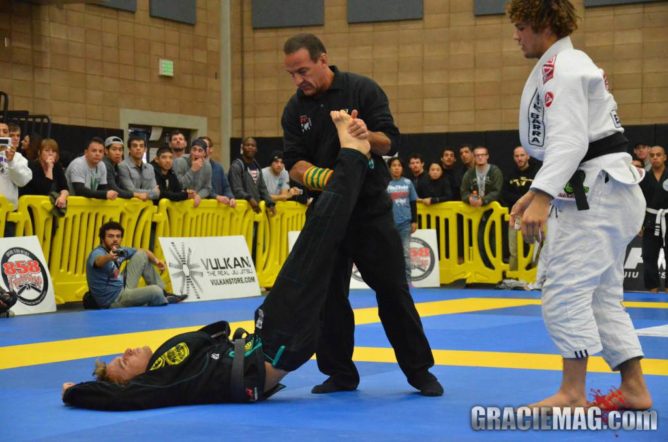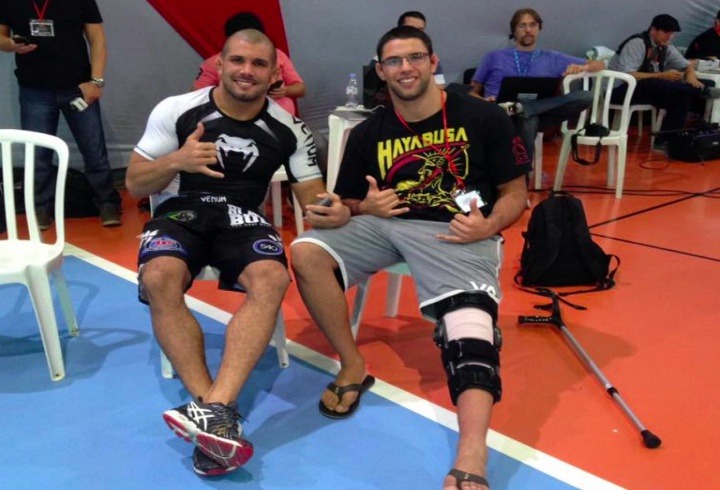
The BJJ academy you go to should be the safest place you visit during the day. People have to feel safe on the mats, even when things go wrong. Injuries are a part of any sport, like it or not. When I come to combat sports, particularly grappling, they’re pretty much inevitable. Usually, it’s no more than a bent finger, a bruise, or a nasty twist of a joint. However, in certain cases, there can be injuries that are of a more serious nature. During such times, it is the instructor/coach/professor’s knowledge and reactions that help guarantee BJJ safety for the injured student.
Practicing a martial art where the ultimate goal is to break any and all joints in the body or strangle someone unconscious, injuries will happen. Usually, they’re just accidents that nobody can really predict or do anything to prevent. Regardless of how an injury comes to happen, or any sort of health issue for that matter, it is the response that matters. Not making things worse, helping the person in question, and making sure nobody else suffers a similar thing is what BJJ safety within an Academy is all about.
BJJ Safety 101
While we all know what we’re going into when we get that Gi on and slap and bump, nobody likes to emerge out of a roll with an injury or any sort of health issue. Yet, sometimes, it is going to happen. At this point, it does not matter where the responsibility lies, but rather what we do to make things better. Even the best-intentioned folks can make a mistake, or slip, and there’s no reason to hold things against them.

A huge aspect of BJJ safety, particularly during unwanted injuries is knowing what to do if you’re on the receiving end. You might just get choked out to sleep, or you might’ve really messed up an ankle or a shoulder. The main thing to do is not try to fix it yourself or walk things off. Accept that something happened and wait, or better yet, call for the person responsible. That said, every academy should have someone trained in first aid in order to provide BJJ safety for students. That is the only person, apart from perhaps an ER doctor that might be training, that should come near an injured student on the mats.
On that note, first aid training should be mandatory, as well as the presence of a first aid kit. More on that later, but of a BJJ gym does not have someone that’s adequately trained to cope with people getting choked out, skeletal or muscle injuries, people fainting, and all other common ailments you might run into in a gym, I’d recommend that you look for a different facility to train at.
What To Do When People Are Choked Out
Something that is common in Brazilian Jiu-Jitsu is someone going to sleep. Let me be clear from the start – this should not happen in training. Tap early and respect your partner’s tap. If you follow this simple rule, nobody is going to fall asleep. And if your instructors insist you need to feel what it is like, change the gym immediately. That is not an environment that can guarantee BJJ safety.
Still, someone will fall asleep from time to time. It can be in training, or it could be at a tournament. While not a naïve thing, being put to sleep with a chokehold is not dangerous if the person doesn’t hold on to it for quite some time. The odds of that happening are slim to none in any BJJ gym. However, when someone goes to sleep, there are certain protocols to follow, in order to make sure they don’t suffer any consequences.

If a person has trouble breathing, and the airway is clear, make sure you do a little massage of the throat/neck to stimulate blood and airflow. Once everything is ok, lift the legs again to help them recover. Also, keep in mind that people might have an underlying condition of sorts that might their response to being choked out or the risk of a serious complication greater.
In a worst-case scenario of someone not breathing, start CPR while someone calls and ambulance.
The thing to remember is that if someone s choked out, they‘re done for the day. It doesn’t matter if it is the first roll – they rest for a while where you can see them and go home, preferably not driving themselves.
Coping With Limb Injuries
When trying to provide BJJ safety for everyone, limb injuries will be the number one thing you tackle. Chokes do happen, but they’re few and far between. Twisted ankles, blown knees, perhaps even a broken bone or two are stuff that you’ll surely see as an instructor/coach/Professor.
When it comes to limbs, the golden rule of immobilizing two neighboring joints always applies. In most cases, it will be dislocations or torn ligaments you’re dealing with, rather than broken bones. Whatever the case, the thing to remember is to assess whether the injury is severe to require a reaction from you, or is mild enough for the person to just R.I.C.E. (Rest, Ice, Compression, Elevation) it.

From a BJJ safety standpoint, this applies to limb injuries only. If you’re trained in First Aid then you’ll know how to handle anything, from a dislocated patella to an open femur fracture, and all the tools you need will be in a well-stocked First Aid kit.
Know Your Limits
The key part about guaranteeing BJJ safety to people inside an Academy is knowing your limits. This is not some ER TV show and you can’t just fix everything. That is precisely why I emphasized limb and muscle injuries above. In the case of severe bleeds, spinal trauma, head trauma, etc. act only in accordance to Firs Aid guidelines to help stabilize someone and immediately call an ambulance.
If you really want people to be safe, then be aware of your limitations as the person responsible fr First Aid. Spinal injuries, which tend to happen (although rarely those of a serious nature) are a great example of how patience will do more good than rushed actions. Moving someone that has a spinal injury is never a good idea, even if you have a backboard and all that jazz. Unless you’re an EMT/doctor, and even then, you should just make sure the person is conscious, breathing, and stable. Immediately call an ambulance and let the professionals do their thing.
This is a call I certainly hope no gym owner will need to make. However, it is more important to know when not to do something, rather than when to take action. Unless a person is unconscious and in need f CPR, simply hold their head (in a spinal trauma case), have them lie as still as possible, and monitor them, staying close while help arrives. That is a responsible way to guarantee BJJ safety for everyone in the gym.
What Is In Your Gym’s First Aid Kit?
Finally a few words about your First Aid Kit. Having a gym without a first aid kit is like rolling without submissions – most of your tools are not there, despite you knowing how to use them. To that extent, a First Aid Kit geared up for BJJ safety should look something like this:
Athletic Tape
- Band-Aids
- Butterfly Bandages
- Alcohol wipes
- Ace Bandages
- Anti-inflammatory pain reliever – ointment
- Instant cold packs or ice packs
- Antiseptic Ointments and sprays
- Trauma Scissors
- Latex Gloves and/or Non-Latex Gloves
- Tweezers
- Sterile Gauze pads
- 1 breathing barrier with one-way valve
- Absorbent compresses
All In All
Instructors/gym owners, take BJJ safety it seriously. The sport is risky enough on its own, and it could be catastrophic if nobody on the mats can come to the aid of someone in need. Make sure you or your staff is trained in giving first aid, and have the necessary equipment on hand. Students, you also have a huge part to play in this. If you’re ever injured and in need of help listen to what you’re being told by the person in charge. It is rare that serious help is needed in a BJJ academy, but anything can happen, so let’s try and stay as safe as possible.












































